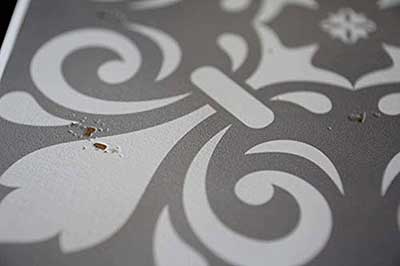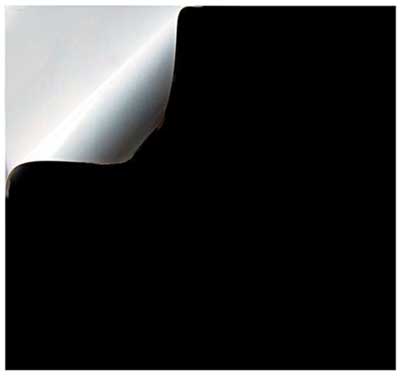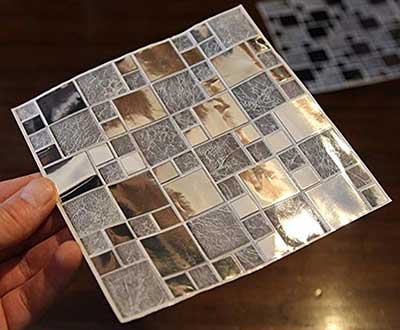How do you cover old kitchen tiles? Bathroom Tile Stickers Removable?
I have made videos to answer your questions.
A tile sticker is peel-off adhesive label made from paper, printed on and then laminated. It could also be made of foil or vinyl. They can be a single plain color or printed with a design. Initially intended to be sited on existing ceramic tiles of certain sizes, and other flat surfaces, for the purpose of changing the look of the décor. As time has progressed they have also found to be useful in other situations as discussed later.
If you want to just buy best quality tile stickers then I have done the research for you and here you have reasonably priced and really good quality tile transfers:
Yes, id did test them and these are fine to use, much better than some others that I have used in the past. What are tile stickers?
What are tile stickers?
Names used for tile stickers.
You may see tile stickers advertised for sale under a variety of different names. Tile stickers, decals and transfers are the most common names in use. However, not all of those are the same thing.
Transfers (beware)
The word ‘transfer’ has many different meanings. In the technicalities of printing a ‘transfer’ literally means transfer the ink from one surface to another. For the purpose of the transfer, the ink is held in place with a bonding coat applied to its surface. That is not what tile stickers do. A tile is printed and the ink is NOT transferred but is applied complete with its carrier backing which also carries the ‘sticky’ adhesive coat on its reverse side.
Be careful if you order tile transfers. A true transfer is only an ink pattern laid over a tile, not a sticker that covers the tile. Generally, transfers are not hard wearing and can be unsuitable for use in kitchens and bathrooms.
Decals
The word ‘decal’ was formed around the year 1937 and was used to replace the word ‘transfer’ when it came to making a transfer of ink. Originally, this was so it identified ink transfers compared to all other meanings of the word transfer. The other meanings relate to movements of people, data, an exchange of goods, those sorts of transfer. However, words often change meanings over the years and now ‘decal’ is often used to also mean tile stickers too.
Tile Stickers
A sticker is something made of a flexible material with a self-fixing adhesive on the back and a message, color or design printed on the front. A tile sticker means that is either cut to a regular shape and size of particular ceramic tiles, or it is printed to resemble a wall tile or tiles on its front surface. They are designed to cover existing tiled surfaces. Calling them tile stickers fits their description and possible use perfectly
Defining what a tile sticker is…
The above description defines exactly what a tile sticker is. Flexible with sticky on the back and tile pattered on the front. In addition to the many different single color and patterned glossy finishes on the more common flat 2-dimensional stickers, or 2D stickers for short, there is now also the option to have mosaic styled 3 dimensional stickers.
The 3D stickers are slightly different in how they are made because they have an adhesive backed foil base sheet and patterned vinyl tops that are shaped and colored to represent a whole variety of different mosaic patterns. The vinyl is then given a flexible gel coating to give it depth and that 3D look. All 3D tiles have a gloss finish and some even have sparkly bits in them.
Where wall tile stickers really score well is their low price, speed of installation and the ease with which they can be removed or replaced when you feel like having a change of decoration.
…and what it isn’t.
What a tile sticker is NOT is a hard ceramic tile, or any other hard material. While tile stickers look the part aesthetically and can be water and heat resistant, they do not have exactly the same hard wearing qualities as ceramic, clay or quarry tiles do. Nor do all manufacturers tile stickers keep their color over time, whereas ceramics don’t fade.
Warning!
Wall tile stickers are NOT suitable as floor tile stickers. While wall tile stickers will withstand dirt, heat and constant wiping on walls, they do not stand up to the scuffs and scratches of everyday footwear. You would be able to find out a bit more about floor tile stickers later on.
How do you cover old kitchen tiles?
Yes, use tile stickers or tile transfers or tile decals and here is a video showing how easy it is. I am showing how to accommodate a tile sticker around wall socket and what to do when your tiled wall is not equally square and fair.
Different tile sizes
In the USA they are all imperial sizes while in Europe they are all metric sizes.
In the UK, for many years the standard tile size was 6” x 6”, joined later by 4” x 4” tiles. Then UK tiling went metric. This was because UK decided to adopt many of the European metric systems. The main reason for this being that it is easier to code computers for using metric units of any kind.
So now the tile sizes became 150mm x 150mm and 100mm x 100mm. Currently, the UK has a mixture of all four sizes plus some new non-standard sizes too.
While there is only a slight difference in imperial to metric sizing, it can cause problems, or additional work, when it comes to tile stickers. The width of the grout between tiles may also have some bearing on size matching too. That’s because some tile stickers come with grout effects either around or between smaller patterned tiles and this effect can look different to the original tile grout.
Tile Stickers Calculator is a useful tool:)
How to calculate how many tile stickers are you going to need to cover your tiled area?
Please watch the video first:)
I know what you are thinking right now, how do I know how many tile stickers am I going to need for my project?, right? Well the Good news is you do not have to be worry about that as I have explained the right way of calculating the right stickers quantity and even I have created a Tile Sticker Calculator that will do all the job for you.
This tool estimates the total number of tiles necessary to cover a floor, roof, wall, or any other surface. It also considers the gap or overlap between tiles for better accuracy, as shown in the figure below.
Number of Tiles
0
Recomended Number of Tiles
0
Get samples if you can
While it may be possible to get the same size of sticker for covering your existing tiles, the best way to check you are correct is to order a couple of sample stickers or if samples are not available then you can get the smallest pack available. You can then see if they fit perfectly or if you have to slightly trim to fit. Take note of how the grouting will look too.
Bathroom Tile Stickers Removable?
Warning!
Just be aware that like how wallpaper is made in batches, where you have to make sure you get rolls from the same print batch otherwise there may be a slight color difference, it is the same with printed tile stickers. This means the two tiles you buy as a sample may not exactly color match your main purchase of tile stickers. So do not rely on ordering two tiles short and hoping they will match. They probably won’t.
Different tile finishes
There are numerous designs, colors and finishes on tile stickers.
Most tile sticker finishes are hard gloss, just like the ceramic tiles you’ll be placing them over. By attaching a sticker to your existing ceramic tiles you can change the color of the entire tiled area.
Another possibility is to just cover some of the tiles with either different colored stickers or with stickers that have a pattern on them so it creates a highlight effect. Different focal points that can change the whole feel of the room, not just the tiling.
One use of the 3D finish tiles is to create a border or feature line. When doing this, a strong contrast of color always looks much better than tiles of a similar color. Border tiles do not need to be the same size or shape as the rest of the tiles in the area covered. That is one of the reasons 3D tiles are used as they give good tile coverage.
Other finishes are often being tried out. One I’ve seen has a leatherette type of finish. One of the problems with that finish was it needed a much thicker tile which is not so easy to cut and apply smoothly.
Read also: Best colour ideas that work in a kitchen
Looking Beautiful… Eventually
I think most of us know by now that anyone buying a table from Ikea doesn’t have something that looks like a table when they get it home. It’s just a pile of wood, some fixings and a set of instructions until it’s been assembled into something that looks nice and is practical.
Unfortunately, wall tile stickers suffer from pretty much the same problem. They only look their best once they are on the wall in the place they were meant to be.
I think it must the biggest complaint that I hear from tile sticker users and reviewers. “When I opened the envelope the stickers came in, they didn’t look particularly good. The quality looks a bit suspect too. Not what I expected!” Only after fitting do people appreciate that they really can look good. As some of the more honest reviewers say.
It’s strange, but there are a lot of household decorations that have a similar problem. For instance, when you open a tin of paint it’s wet and not the same color as it will be when dry, to say nothing of the shape it takes.
I think the biggest shock I ever got was when I once bought a painting by mail order. It came rolled up in a cardboard tube and looked rather cheap and poor quality, just vaguely like what I thought I’d ordered. Only after I got it back from taking it to be framed did it look every bit as gorgeous as my mind had imagined it when I had first seen it.
So please don’t feel disillusioned or disappointed when you first get your stickers. Just keep thinking how good they will look once they are in place. You have to fit them properly of course, plenty of instructions for how to do that coming later, but once they are on they will NOT cheapen the look of your home. Quite the reverse. Many people can’t tell the difference between the finish a tile sticker gives and a real ceramic tile just from looking at them.
What else can you use tile stickers for?
The real answer to that is “Whatever your imagination will come up with” but, as we’ve already found out, there are limitations which I’ll go over again shortly.
Apart from using them as complete tile coverings as they are, I suspect there are many uses that people have put them to that I’ve never heard of. It would be nice to hear from you if you’ve put them to some unusual use sometimes. I might update this section and add some of your suggestions in here.
Here are some of the ways I have heard of them being used:
Folks have bought second user or recycled furniture like coffee tables, sets of drawers, bedroom furniture and children’s furniture etc. and, apart from painting them to look more modern, they have also added some patterned stickers to them in order to create something really unique. They don’t always use the stickers ‘as is’ either. They cut them into shapes or form letters to make names out of them. Somebody cut wave shapes out of blue and white stickers and put them across the bottom of their bathroom mirror.
Dolls house wallpaper seems to have cropped up a few times. While we would not advocate using the stickers on anything really small children might test by chewing on them, they are good for decorating things that older children use. Putting them on their school books seems to be a popular way to customize their personal property.
Should you decide you’d like to try to cut some specific shapes out, animal or bird shapes for instance, but don’t think your drawing capabilities are up to it, one way is to look for cheap objects you could easily draw around. Cookie cutters are a favorite for this. You might also be able to print things from the Internet then use them for a pattern. It’s so easy these days and to be honest, you don’t always need them to be absolutely perfect do you?
Checkmate
One enterprising woodworker also liked to play chess. So he turned some wood and did some carving to make the chess pieces. Then, when it came to making the chessboard, he found that the sticky tiles didn’t scuff and were a lot easier to apply than trying to paint a checker pattern on the board that he’d got; so he cut white and black tiles into squares to cover his chessboard. Even used them to create a nice border around it.
You might think that chessboards don’t scuff! Normally you’d be correct. However, as he didn’t have a lot of time for sitting down to play chess and his wife, who also liked to play, thought they couldn’t have the set on display all the time because of their small children getting to it, he made it into a magnetic chess set.
He bought a set of 36 circular magnets with a hole through them so they could be screwed to his homemade chess pieces. The 4 remaining magnets were used as markers on an adjoining board to signify who’s turn it was, whether or not someone was in check or checkmate and a spare for each player in case a pawn got to the opposing side of the board and got his rank raised.
He screwed the sticker covered metal boards on the wall in their porch. That way, whenever he or his wife passed the board they could see the state of play and who’s turn it was without their chess partner being around or the children being able to reach it. What usually happened of course was that when a finish to a game looked close, they would often stand together in the porch battling out the last moves.
Limitations of sticker use.
All of the above example used the stickers on perfectly flat surfaces and were not used where they were likely to get scuffed with use unless they were in place where it didn’t matter too much as their period of use was probably relatively short. I’m thinking of schoolbooks and children’s furniture here in particular.
Where a surface is not flat or good for sticking to, or where a lot of heavy duty use is probable, then stickers of any kind are not a particularly good fit for those environments.
More interested articles: The Best Kitchen Revamp Ideas, Why Are Cheap Tile Stickers Good? How to Fix Glass Splashback? Vinyl Flooring?





